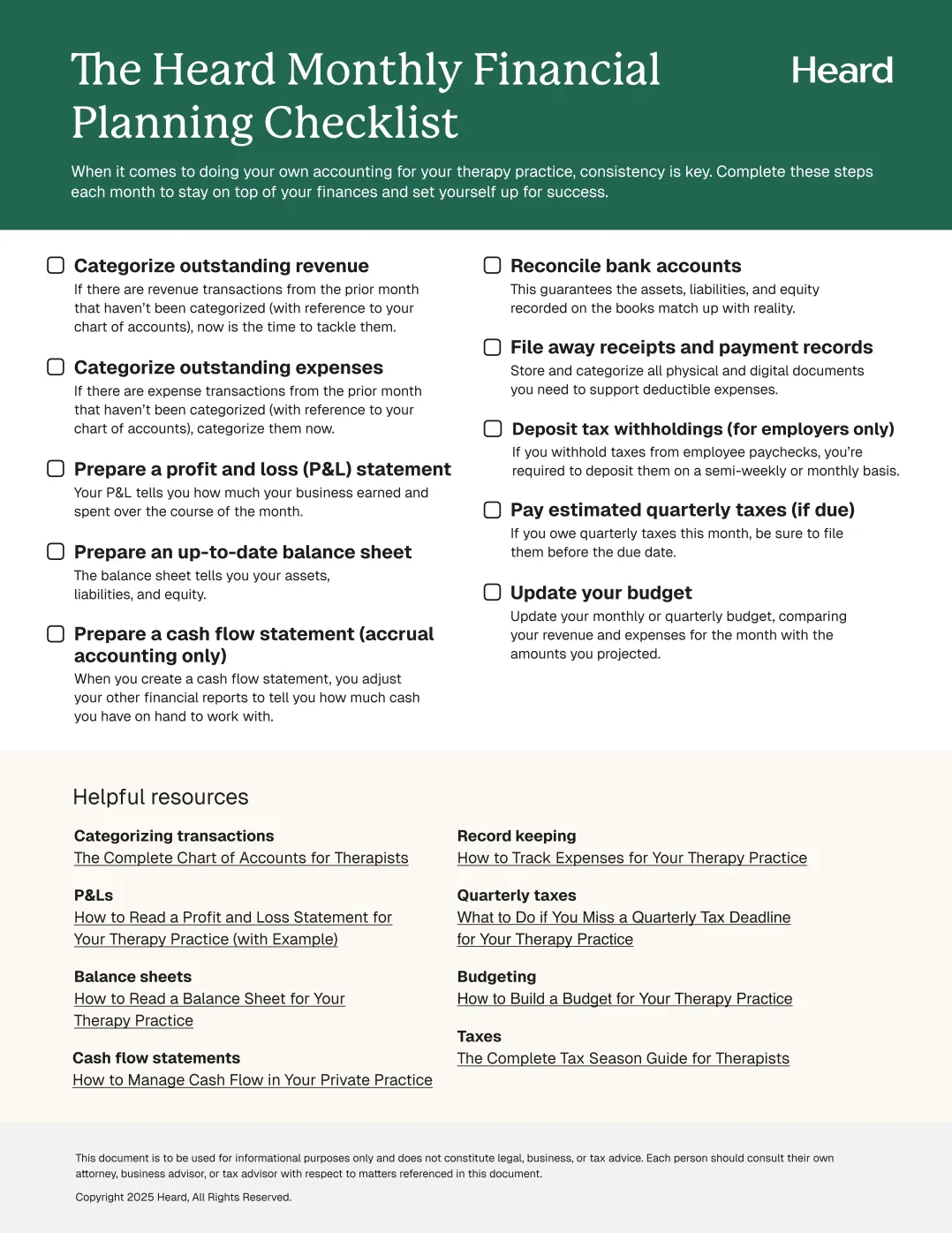Stable long-term investments are a smart move when you run your own therapy practice. Being self-employed, you don’t have the luxury of an employee pension plan.
Putting away funds in an IRA or a 401(k), keeping your HSA topped up, and investing in mutual funds, bonds, ETFs, and other safe bets helps you prepare for the future. You may even reduce your tax burden while you’re at it.
But client turnover, seasonality, and new-practice growing pains may disrupt your plans. Without a steady income, how can you steadily increase your investments?
Here’s a simple plan for investing in the future when your weekly paycheck is hard to predict.
{{resource}}
Investing with help from the 50/20/30 rule
The 50/20/30 rule is a well-worn personal finance hack for planning how you spend your income.
It works by breaking your after-tax income into parts:
- 50% is budgeted to cover non-discretionary expenses. Examples include rent, groceries, gas, car insurance, and utility bills.
- 20% is budgeted for saving. “Saving” in this case includes long-term investments.
- 30% is budgeted for discretionary expenses. These include meals out, movies, games, travel—anything you could (technically) live without.
The percentages of the 50/20/30 rule are arranged in order of importance. That is, your number one priority should be covering non-discretionary expenses (the cost of living). Second in terms of priority is saving (preparing for the future). Only after that do you worry about paying for entertainment and the rest.
If you’re having trouble putting aside money each month for long-term investments, the 50/20/30 rule could solve the problem. That being said, you may need to tweak it to suit your personal situation.
For instance, if you live in an area where rent is especially high, 50% of your income may not be enough to pay for non-discretionary expenses. Likewise, if you’re late to the game saving money for retirement, you might opt for a more aggressive 25% or 30% share dedicated to savings and investment, while shrinking your discretionary expense budget.
The 50/20/30 rule may be hard to stick with if your income changes month to month. You need to stabilize your income first. That’s where the real work of budgeting for investments comes in.
The investment-first attitude
As a supplement to the 50/20/30 method, you may want to think of your investments as an “above the line” item.
That is, before you even start divvying up your paycheck to cover discretionary and non-discretionary expenses, set aside funds for your investments.
No, it doesn’t practically impact where your money goes—you’ll still be following some version of the 50/20/30 division. But it may help you adopt an investment-first mindset, and avoid any temptation to divert potential savings to other parts of your budget.
Note: In some cases, investing really is an above-the-line item. Contributions to traditional IRAs and 401(k)s are pre-tax, meaning income tax is deferred until you withdraw the funds in retirement. For more info, check out How to Choose a Retirement Plan for your Therapy Practice.
{{resource}}
How to budget for investing with a variable income
Particularly if your practice is a sole proprietorship, you may find yourself treating your business bank account like a wallet. That is, whenever you need cash, you pull it out of your business; whenever you have enough cash, you let your business capital grow.
That approach makes it impossible to stabilize your personal income.
If you want to budget for investing, the first step is to determine how much you need to cover personal expenses each month. Then, you can set a stable income for yourself. In effect, you’ll be cutting yourself a paycheck every two weeks.
Here’s how.
Determine your business’s average monthly income
By nature, variable income is hard to predict. Nonetheless, based on your total profits last year, how much can you expect to earn this year?
For instance, if your practice earned $64,000 after taxes last year, your average monthly income was a little over $5,300. Use that amount to anticipate your average monthly income for the current year.
Determine your non-discretionary expenses
How much do you need each month in order to live? Add up your recurring expenses (rent, insurance payments). Then calculate your average spending on essentials like groceries.
Add up all of your non-discretionary expenses to determine a monthly average cost. The total amount will comprise 50% of your paycheck (assuming you follow the 50/20/30 rule).
Set your salary
Since the goal is to have non-discretionary expenses make up 50% of your monthly budget, your monthly income should be twice the total cost of your non-discretionary expenses.
For instance, suppose rent/mortgage, groceries, gas, car insurance, and the rest cost you $2,400 per month. In that case, you should plan on paying yourself $4,800 each month (or $2,400 every two weeks).
Open a reserve account
In some months, your gross income will be higher than average; after paying your own wages, you’ll have money left over.
In other months, it will be lower than average; you may even find you don’t earn enough to cover your paycheck.
That’s where your reserve account comes in. Whenever you have excess income above your wages, divert it to the reserve account. Whenever your income comes up short, make up the difference with a withdrawal from the reserve account.
Your reserve account is separate from the bank account where you set aside emergency savings or tax withholdings. And money you divert from your income should always go to your reserve account, rather than a long-term investment account. Your goal is to have liquid assets (cash) readily on hand to cover your wages during slow months.
Remember, you have 20% of your net income, designated in the 50/20/30 plan, to spend on investments or save in a tax-advantaged account.
Your reserve account is the key to stabilizing your income, cutting yourself a regular paycheck, and ensuring you have the cash on hand to make regular contributions to your investment portfolio.
{{resource}}
Reinvesting in your business with a variable income
This plan for stabilizing your income and setting aside money for investments has only to do with your personal income.
Some of your practice’s income must be spent on operating expenses. In fact, if your practice is an S corp, your wages are operating expenses, and deductible from your business’s taxes.
For help reinvesting in your practice—and keeping the lights on—check out How to Build a Budget for your Therapy Practice.
—
Looking for ways to invest a portion of your income? Look no further than 5 Investment Strategies for Therapists.
This post is to be used for informational purposes only and does not constitute legal, business, or tax advice. Each person should consult their own attorney, business advisor, or tax advisor with respect to matters referenced in this post.
Bryce Warnes is a West Coast writer specializing in small business finances.
{{cta}}
Manage your bookkeeping, taxes, and payroll—all in one place.

Discover more. Get our newsletter.
Get free articles, guides, and tools developed by our experts to help you understand and manage your private practice finances.





